Similar presentations:
Environmental Administration and Legislation
1. Environmental Administration and Legislation
Mikkeli Universityof Applied Sciences
Autumn 2016
2. Dia 2
REVISIONWhat did you learn last week?
8.11.2016
Environmental Administration and Legislation,
2016
2
3. To begin at the beginning…
The environmental impact assessment mustidentify the direct and indirect effects of a
project on:
–
–
–
–
8.11.2016
man, the fauna and the flora,
the soil, water, air, the climate,
the landscape, the material assets and cultural heritage
and the interaction between these various elements.
Environmental Administration and Legislation,
2016
3
4. Projects
An assessment is obligatory for certain projects:dangerous industrial facilities such as oil refineries, nuclear fuel or nuclear
waste treatment facilities, integrated chemical installations;
power stations of more than 300 megawatts or nuclear power stations;
transport infrastructure such as railways, airports, motorways, inland
waterways and ports when the infrastructure exceeds certain specific
thresholds;
waste and water treatment facilities;
large mining facilities (large quarries, large gas or oil rigs);
water transport or storage facilities, and dams;
installations for the intensive rearing of poultry or pigs which exceed certain
specific thresholds.
Look for a list in ANNEX II of the directive (and in relevant national legislation)!
8.11.2016
Environmental Administration and Legislation,
2016
4
5. Dia 5
The operatorContact authority
Beginning of EIA
The Public
Authorities
Interested parties
EIA
Programme
Publication of the EIA
Programme
Adjustment of
the EIA
Programme
Statement of the EIA
Programme
Opinions and
Statements
EIA Report
Publication of the EIA
Report
End of EIA
-> env. permit
procedure
Statement of the EIA
Report
Opinions and
Statements
6. Project Participation Opportunities
1. Participation opportunity at EIA –programme stage
2. Participation opportunity at EIA –
report stage
3. Opinions/ statements on
Environmental Permit decision
4. Appeal on Environmental Permit
decision
8.11.2016
Environmental Administration and Legislation,
2016
6
7. Dia 7
IPPC8.11.2016
Environmental Administration and Legislation,
2016
7
8. Dia 8
• Prevention of discharge of harmfullsubstances
• Controlling activities leading to specific risks
→ IPPC
8.11.2016
Environmental Administration and Legislation,
2016
8
9. Directive 2008/1/EC (2008) concerning integrated pollution prevention and control
Directive 2008/1/EC (2008) concerningintegrated pollution prevention and control
• “The IPPC Directive” requires activities with a high
pollution potential to have a permit.
• Combines elements of separate environmental media
related permitting procedures (water, waste…)
• Environmental permit can only be issued if certain
environmental conditions are met, so that the companies
themselves bear responsibility for preventing and
reducing any pollution they may cause.
• Information on environmental performance must be
made available to interested parties
• International environmental agreements?
8.11.2016
Environmental Administration and Legislation,
2016
9
10. Industrial emissions IPPC directive
• Directive 2010/75/EU on industrial emissions (integratedpollution prevention and control).
– Similar obligations as the IPPC Directive
– Replaced the with effect from 7 January 2014 Directive
2008/1/EC concerning integrated pollution prevention and
control
• covers industrial activities with a major pollution potential
8.11.2016
Environmental Administration and Legislation,
2016
10
11. Categories of activities
Energy industries
Production and processing of metals
Mineral industry
Chemical industry
Waste management
Other activities, e.g. industrial production of pulp, tanning
of hides…
8.11.2016
Environmental Administration and Legislation,
2016
11
12. With special provisions for
combustion plants (≥ 50 MW);
waste incineration or co-incineration plants;
certain installations and activities using organic solvents;
installations producing titanium dioxide.
8.11.2016
Environmental Administration and Legislation,
2016
12
13. IE Directive
“To control industrial emissions, the EU hasdeveloped a general framework based on
integrated permitting. This means the permits must
take account of a plant’s complete environmental
performance to avoid pollution being shifted from
one medium - such as air, water and land - to
another.
Priority should be given to preventing pollution by
intervening at source and ensuring prudent use
and management of natural resources.”
8.11.2016
Environmental Administration and Legislation,
2016
13
14. IPPC obligations*
All installations covered by the directivemust prevent and reduce pollution by
applying the best available techniques
(BATs), efficient energy use, waste
prevention and management and measures
to prevent accidents and limit their
consequences.
The installations can only operate if in
possession of a permit and have to comply
with the conditions set therein.
8.11.2016
Environmental Administration and Legislation,
2016
14
15. IPPC obligations*
The BAT conclusions are the reference forsetting the permit conditions.
Emission limit values must be set at a level
that ensures pollutant emissions do not
exceed the levels associated with the use of
BATs. However they may, if it is proven that
this would lead to disproportionate costs
compared to environmental benefits.
8.11.2016
Environmental Administration and Legislation,
2016
15
16. IPPC obligations*
• Competent authorities need to conduct regularinspections of the installations.
• The public must be given an early opportunity to
participate in the permitting process.
8.11.2016
Environmental Administration and Legislation,
2016
16
17. Dia 17
Environmental Permit8.11.2016
Environmental Administration and Legislation,
2016
17
18. Legislative Instruments
A permit is a powerfull tool for execution of environmentallegislation – without the permit the operator is not allowed to
operate and by applying for the permit he subjects the
operation to assessment by the authorities and the public.
8.11.2016
Environmental Administration and Legislation,
2016
18
19. Other permits, reminder
Besides the IPPC (environmental) permit, there are otherpermit procedures in environmental legislation as well:
• Nature conservation permits
• Water legislation permits
• Land extraction permits
• Building permits
• Transfrontier shipments of waste…
8.11.2016
Environmental Administration and Legislation,
2016
19
20. IPPC permit includes*
• emission limit values for polluting substances– listed in Annex II;
• any soil, water and air protection measures
required;
• waste management measures;
• measures to be taken in exceptional
circumstances;
8.11.2016
Environmental Administration and Legislation,
2016
20
21. IPPC permit includes*
• requirements concerning the maintenanceand surveillance of soil and groundwater;
• minimisation of long-distance or
transboundary pollution;
• emission monitoring; requirements
concerning emission measurement
methodology, frequency and evaluation
procedure;
8.11.2016
Environmental Administration and Legislation,
2016
21
22. IPPC permit includes*
• an obligation to inform the competentauthority of the results of monitoring, at
least annually
• conditions for assessing compliance with
the emission limit values.
• all other appropriate measures.
8.11.2016
Environmental Administration and Legislation,
2016
22
23. Who needs a permit?
8.11.2016Environmental Administration and Legislation,
2016
23
24. Environmental Permits: Finland
According to Finland's environmental protection legislation, permitsare needed for all activities involving the risk of pollution of the air
and water or contaminating the soil. One important condition for
permits is that emissions are limited to the levels obtainable by
using Best Available Techniques (BAT).
Environmental Protection Act includes a list of activities that need an
environmental permit.
8.11.2016
Environmental Administration and Legislation,
2016
24
25. Environmental Permits: Finland
Environmental Protection Act includes a list of activities that need anenvironmental permit:
1. Energy industries
2. Production and processing of metals
3. Mineral industry
4. Chemical industry
5. Waste management
6. Other activities
8.11.2016
Environmental Administration and Legislation,
2016
25
26. Environmental Permits: Finland
In addition to those, the relevant authority may- after consideration –require a permit from other activities that (e.g.)
• may cause pollution of a water body,
• referred activities that may place an unreasonable burden on the surroundings, referred to in
section 17(1) of the Adjoining Properties Act (26/1920);
• treatment of waste on a professional basis or at an installation, within the scope of
application of the Waste Act;
• test drilling for oil or gas, the exploitation of a deposit and other related activities in Finnish
territorial waters and in Finland's exclusive economic zone.
8.11.2016
Environmental Administration and Legislation,
2016
26
27. IPPC permits
• E.g. in Finland the permit procedure andthe contents of a permit are desrcibed in
the Environmental Protection Act.
• Permits are issued by environmental
authorities, as also described in the
Environmental Protection Act
• Authorities monitor compliance with the
permit requirements.
8.11.2016
Environmental Administration and Legislation,
2016
27
28. Environmental Permits: Finland
Applications must be made to the relevant authority, as defined inthe Environmental Protection Act and Decree.
Reminder: Permit authority and supervising authority
8.11.2016
Environmental Administration and Legislation,
2016
28
29. Dia 29
The use of BAT mustbe considered, when
deciding on the permit,
More about defining
BAT later...
8.11.2016
Environmental Administration and Legislation,
2016
29
30. Dia 30
IPPCPermit Procedure and Public Participation
Finland as example
8.11.2016
Environmental Administration and Legislation,
2016
30
31. Dia 31
8.11.2016Environmental Administration and Legislation,
2016
31
32. 1. Permit application*
• Applications must be made in writing to the competentauthority, as defined in the Environmental Protection Act
and Decree.
Why in writing?
• Prior to environmental permit application EIA (when
applicable) must be completed!
8.11.2016
Environmental Administration and Legislation,
2016
32
33. Content of the application
1) the name and contact details of the applicant plus thename, business sector and location of the facilities
concerned;
2) details of the property and the facilities and activities
located thereon plus the proprietors of said facilities;
8.11.2016
Environmental Administration and Legislation,
2016
33
34. Content of the application
3) a general description of the activities concerned;4) information on output, processes, equipment, structures
and their location which is relevant to consideration of the
application;
5) information on the location of activities and local
environmental conditions;
8.11.2016
Environmental Administration and Legislation,
2016
34
35. Content of the application
6) information on the quality and quantity of discharges intowater, air and soil and on noise and vibration caused by the
activities;
7) information on the types, quantities and properties of
waste generated by the activities;
8) an assessment of the environmental impacts of the
activities;
8.11.2016
Environmental Administration and Legislation,
2016
35
36. Content of the application
9) the scheduled date for thecommencement of activities; note: it is
possible to apply for permission to
commence regardless of appeals!
10) an account of the immediate neighbours
bordering on the site of the activities and
any other interested parties who could be
especially affected by the activities and their
effects.
8.11.2016
Environmental Administration and Legislation,
2016
36
37. Dia 37
8.11.2016www.ymparisto.fi
Environmental Administration and Legislation,
2016
37
38. 2. Publicising of the application*
• The authority must make application public!• The authority asks for statements from relevant parties
and gathers opinions and statements
8.11.2016
Environmental Administration and Legislation,
2016
38
39. 3. Written reply*
The operator is given the possibility to reply to the givenstatements and opinions in order to affect how the authority
will consider them in “permit consideration”
8.11.2016
Environmental Administration and Legislation,
2016
39
40. Dia 40
8.11.2016www.ymparisto.fi
Environmental Administration and Legislation,
2016
40
41. 4. Permit consideration*
The authority must consider– the permit application – the actual activity
• Including assessment of BAT!
– the given statements and opinions
– reply given by the operator
– relevant environmental legislation
• Including land use planning and EIA!
Env Protection Act: Chapter 7 - Permit consideration
8.11.2016
Environmental Administration and Legislation,
2016
41
42. 4. Permit consideration*
Env Protection Act: Preconditions for granting apermit
“Granting a permit requires that the activity,
severally or together with other activities, does
not, taking permit regulations and the location of
the activity into account, result in:
1) harm to health;
2) other significant environmental pollution or
risk thereof;
3) a consequence prohibited in sections 7-9;
8.11.2016
Environmental Administration and Legislation,
2016
42
43. 4. Permit consideration*
4) deterioration of special natural conditions orrisk to water supply or other potential use
important to the public interest in the activity's
area of impact;
5) an unreasonable burden referred to in
section 17(1), of the Adjoining Properties Act.
Activities may not be located in conflict with a
detailed local plan. In addition, the provisions of
section 6 apply to location.
Operators engaged in the disposal of waste shall
possess expertise that is sufficient considering
the type and extent of the activities.”
8.11.2016
Environmental Administration and Legislation,
2016
43
44. Dia 44
8.11.2016www.ymparisto.fi
Environmental Administration and Legislation,
2016
44
45. 5. Permit decision*
• Permits are granted if the preconditions are met.• Possible enforcement orders!
– can be made where there is imminent risk of irreparable
environmental damage.
• Must show how EIA (if applicable) has been implemented
8.11.2016
Environmental Administration and Legislation,
2016
45
46. 5. Permit decision*
Env Protection Act: Chapter 8- Permit decisions Contents of a permit decision• Time of validity “Depending on the matter concerned, environmental permits are
issued either until further notice or for a fixed period.”
• Grounds for the decision “The grounds and justification of the ruling shall be
indicated in the permit decision. The decision must respond to separate demands
made in opinions and complaints.”
• EIA: “When the Act on Environmental Impact Assessment Procedure is applied to a
project, the permit decision must indicate how the assessment has been taken into
account in the permit decision...”
• Details: “More detailed provisions concerning the content of permit decisions are
issued by decree.”
8.11.2016
Environmental Administration and Legislation,
2016
46
47. 5. Permit decision*
• Permit regulations for the purpose of preventingpollution
• Monitoring and supervision regulations
• Regulations concerning emissions into a sewer
• Impact of certain plans and programmes
8.11.2016
Environmental Administration and Legislation,
2016
47
48. Dia 48
8.11.2016www.ymparisto.fi
Environmental Administration and Legislation,
2016
48
49. 6. Publicising of the permit decision*
• Again, the decision must be made available to allinterested parties
• Who is an “interested party”?
–Why is it made public?
8.11.2016
Environmental Administration and Legislation,
2016
49
50. Dia 50
8.11.2016www.ymparisto.fi
Environmental Administration and Legislation,
2016
50
51. 7. Apellate procedure*
• Definition of interested party is important, since only the“interested party” has the right of appeal!
• Appeals on environmental permit decisions in Finland are
made to the Administrative Court of Vaasa, then to the
Supreme Administrative Court within 30 days!
8.11.2016
Environmental Administration and Legislation,
2016
51
52. 8. Legally valid permit*
• After the appellate procedure or – if there are no appeals – afterthe appellate time the permit becomes legally valid and binding.
• Environmental impacts of the activity in question are managed via
the permit requirements -> authorities monitor compliance
• There is a fee for the permit decision!
This should not be confused with penalty fees! It is a fee for the
processing of the permit application.
8.11.2016
Environmental Administration and Legislation,
2016
52
53. Dia 53
Validity of Environmental Permit8.11.2016
Environmental Administration and Legislation,
2016
53
54. Validity of Environmental Permit*
Permits are granted for a fixed period or until further notice– A permit granted for a fixed period expires when the period
ends.
– Permits granted until further notice must set the date by which
an application for the review of permit regulations must be
made and specify any reports that must be submitted in that
connection unless such an order is deemed manifestly
unnecessary.
8.11.2016
Environmental Administration and Legislation,
2016
54
55. Lapsing of a permit
• The authority granting a permit may decide that thepermit lapses if:
– the activity has been suspended for at least five consecutive
years, or the operator reports that the activity will not be started
or that it has been discontinued permanently;
– the activity or measures essential to its initiation have not been
started or taken within five years of the permit becoming legally
valid, or within a longer period stipulated in the permit; or
– the application to review permit regulations has not been
made.
• The case must be processed similarly to a permit
application.
• The case may be initiated by the permit authority on its
own initiative, a supervisory authority, operator,
municipality or party suffering harm.
8.11.2016
Environmental Administration and Legislation,
2016
55
56. Amending a permit
8.11.2016On application by the permit holder, supervisory authority, the
relevant authority protecting the public good or a party
suffering harm, the authority that granted the permit shall
amend it if:
– the pollution or risk thereof caused by the activity is
substantially different than was expected;
– the activity has a consequence prohibited in this Act;
– emissions may be reduced considerably without undue
cost due to advances in best available technology;
-the grounds for a permit condition are found to be incorrect and
amending the condition does not create the need to
reconsider the preconditions for granting the permit;
(588/2011)
-circumstances have changed substantially since the granting of
the permit; or
-it is necessary for the observation of provisions issued for the
purpose of fulfilling an international obligation binding on
Finland.
Environmental Administration and Legislation,
2016
56
57. Revoking a permit
On the initiative of the supervisory authority theauthority granting the permit may revoke it if:
– the applicant has provided erroneous information that
is material to the preconditions for granting the permit;
– permit regulations have been violated repeatedly
despite a written reminder from the supervisory
authority so that the activity poses a risk of
environmental pollution; or
– preconditions for continuing the activity cannot be met
by amending the permit in accordance with section
58.
The case shall be processed similarly to a permit
application, as appropriate.
8.11.2016
Environmental Administration and Legislation,
2016
57
58. Dia 58
BAT8.11.2016
Environmental Administration and Legislation,
2016
58
59. BAT- history
• Concept of BAT first used in the UK “SalmonFishery Act 1861”
• Best available techniques not entailing excessive
costs (BATNEEC) introduced with the 1984 Air
Framework Directive (AFD)
• In the US similar concept found in the CWA and
CAA
• Included in the first IPPC directive (96/61/EC)
8.11.2016
Environmental Administration and Legislation,
2016
59
60. BAT
“The most effective and advanced stage inthe development of activities and their
methods of operation which indicate the
practical suitability of particular techniques
for providing in principle the basis for
emission limit values designed to prevent
and, where that is not practicable, generally
to reduce emissions and the impact on the
environment as a whole”
8.11.2016
Environmental Administration and Legislation,
2016
60
61. … to ”break it down”
• "techniques" shall include both the technologyused and the way in which the installation is
designed, built, maintained, operated and
decommissioned,
• "available" techniques shall mean those
developed on a scale which allows
implementation, under economically and
technically viable conditions,
• "best" shall mean most effective in achieving a
high general level of protection of the
environment as a whole.
8.11.2016
Environmental Administration and Legislation,
2016
61
62. Who determines what is good enough?
• The European IPPC Bureau producesreference documents on BAT, called
BREFs.
• BREFs are the main reference documents
used by competent authorities in Member
States when issuing operating permits for
the installations that represent a significant
pollution potential in Europe.
8.11.2016
Environmental Administration and Legislation,
2016
62
63. Who determines what is good enough?
BAT information exchange is carried out bynational technical working groups (BAT working
groups), which are composed of representatives
from industry and permit authorities and inspectors
– the group chair acts as the national member
in the corresponding Technical Working
Group (TWG) at EU level information
exchange.
8.11.2016
Environmental Administration and Legislation,
2016
63
64. Who determines what is good enough?
– National BAT Working Groups comment ondraft BREFs prepared by the EIPPCB and
gather other relevant background information.
– Results of National BAT information exchange
for different industrial sectors are published as
National BAT technology reports and many of
them have been sent for background
information for BREF's preparation.
8.11.2016
Environmental Administration and Legislation,
2016
64
65. IPPC Bureau
The European Integrated Pollution Prevention and ControlBureau was set up to organise an exchange of information
between Member States and industry on BAT, associated
monitoring and developments in them.
8.11.2016
Environmental Administration and Legislation,
2016
65
66. Dia 66
“Where the competent authority sets permit conditions onthe basis of a best available technique not described in any
of the relevant BAT conclusions, it shall ensure that
technique is determined by giving special consideration to
the criteria listed in Annex III…”
8.11.2016
Environmental Administration and Legislation,
2016
66
67. Criteria for determining best available techniques
1. the use of low-waste technology;2. the use of less hazardous substances;
3. the furthering of recovery and recycling of
substances generated and used in the
process and of waste, where appropriate;
8.11.2016
Environmental Administration and Legislation,
2016
67
68. Criteria for determining best available techniques
4. comparable processes, facilities ormethods of operation which have been tried
with success on an industrial scale;
5. technological advances and changes in
scientific knowledge and understanding;
6. the nature, effects and volume of the
emissions concerned;
8.11.2016
Environmental Administration and Legislation,
2016
68
69. Criteria for determining best available techniques
7. the commissioning dates for new or existing installations;8. the length of time needed to introduce the best available
technique;
9. the consumption and nature of raw materials (including
water) used in the process and energy efficiency;
8.11.2016
Environmental Administration and Legislation,
2016
69
70. Criteria for determining best available techniques
10. the need to prevent or reduce to a minimum the overallimpact of the emissions on the environment and the risks to
it;
11. the need to prevent accidents and to minimise the
consequences for the environment;
12. information published by public international
organisations.
8.11.2016
Environmental Administration and Legislation,
2016
70
71. BAT SELECTION
The selection of Best Available Techniques consists infinding the appropriate balance between environmental
performance and technical and economical availability.
This balance depends on a number of parameters, such as
the projects environmental requirements and goals,
technical constraints, stakeholders expectations and the
economic viability of the project.
8.11.2016
Environmental Administration and Legislation,
2016
71
72. Practical definition of BAT
1. Scope and identify the alternative techniques underconsideration - refer to the BREF(s), relevant site-specific factors,
techniques not covered by BREF.
2. Compile an inventory of emissions and resource use for
each option - significant emissions/resource use, synergistic effects
bioaccumulation, changes within an emissions type
8.11.2016
Environmental Administration and Legislation,
2016
72
73. Practical definition of BAT
3. Estimate environmental effects -may be weighted to reflectcloseness to environmental benchmark Practical definition of Best Available
Techniques.
4. Determine the technique that offers the highest level of
protection for the environment as a whole - equal weight to all
media? Short term vs long term impacts, ozone/global warming potential, noise
and vibration, odour etc -impact on resource use/waste
8.11.2016
Environmental Administration and Legislation,
2016
73
74. Practical definition of BAT
5. Determine the costs for each alternative technique - whatis included and on what basis? -- economic assumptions eg amortisation period
6. Evaluate the alternatives - on what basis? e.g. Benchmark costs/kg
of pollutant Point of more rapidly increasing costs
8.11.2016
Environmental Administration and Legislation,
2016
74
75. BAT as legislative tool
The requirement of BAT alone doesn’t do much, butcombined with permits is a handy tool for putting the
pressure for using the best alternative on those who cause
environmental impacts.
8.11.2016
Environmental Administration and Legislation,
2016
75





















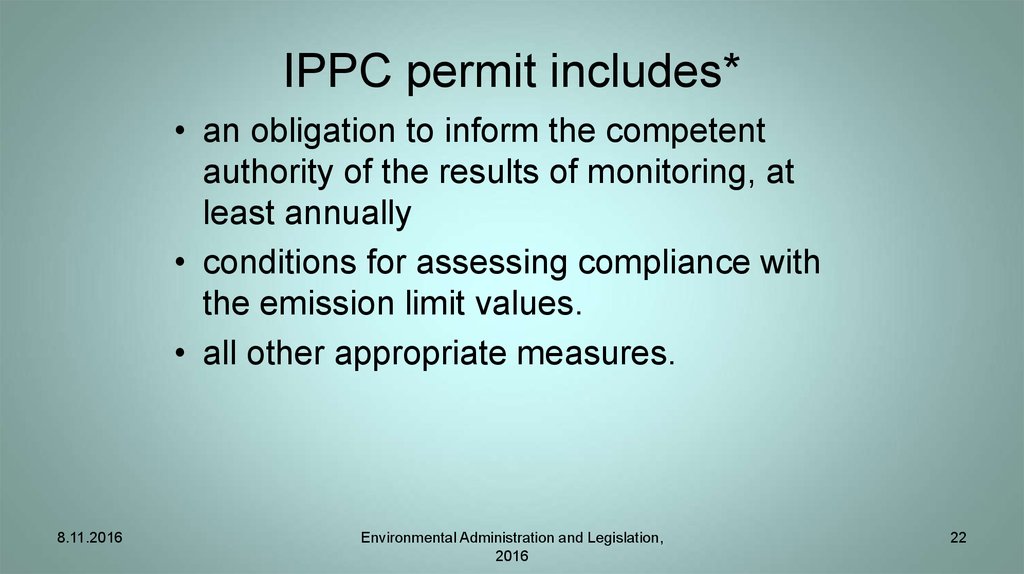

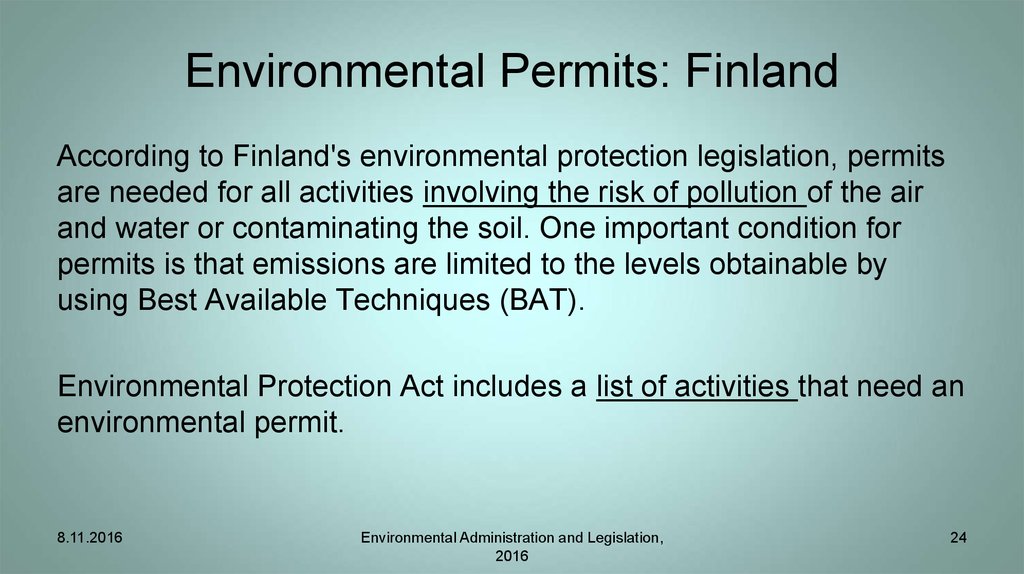



























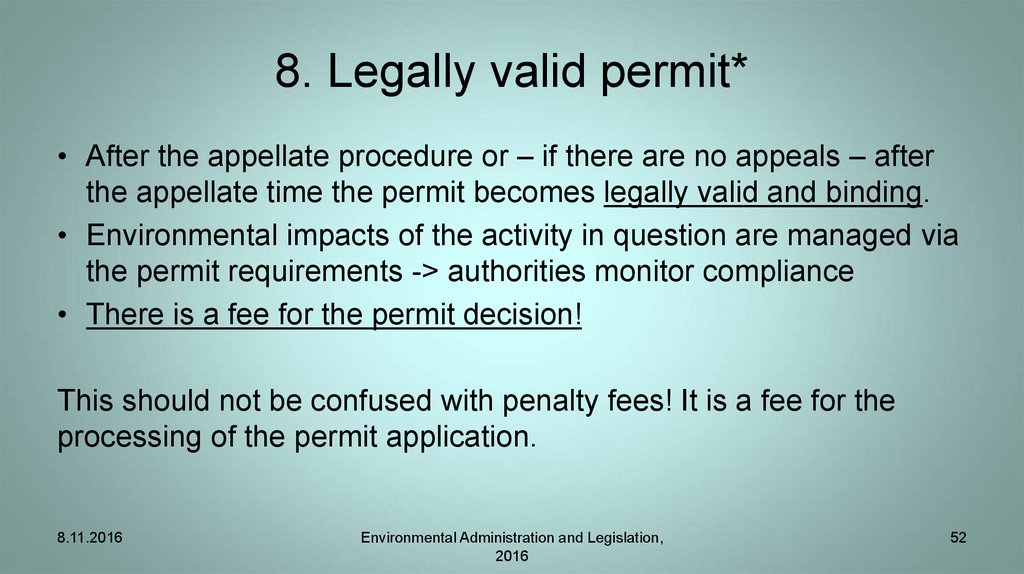





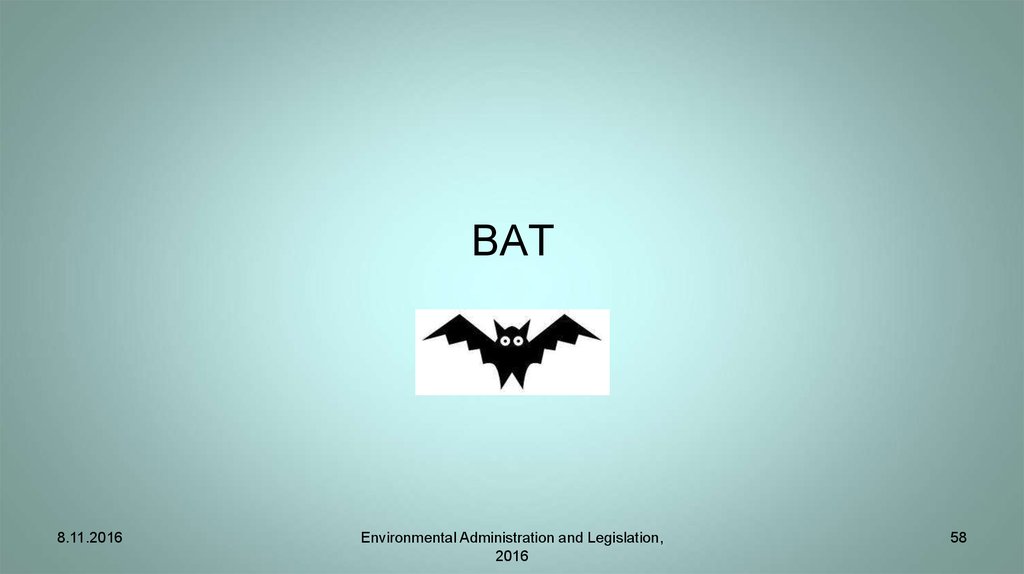

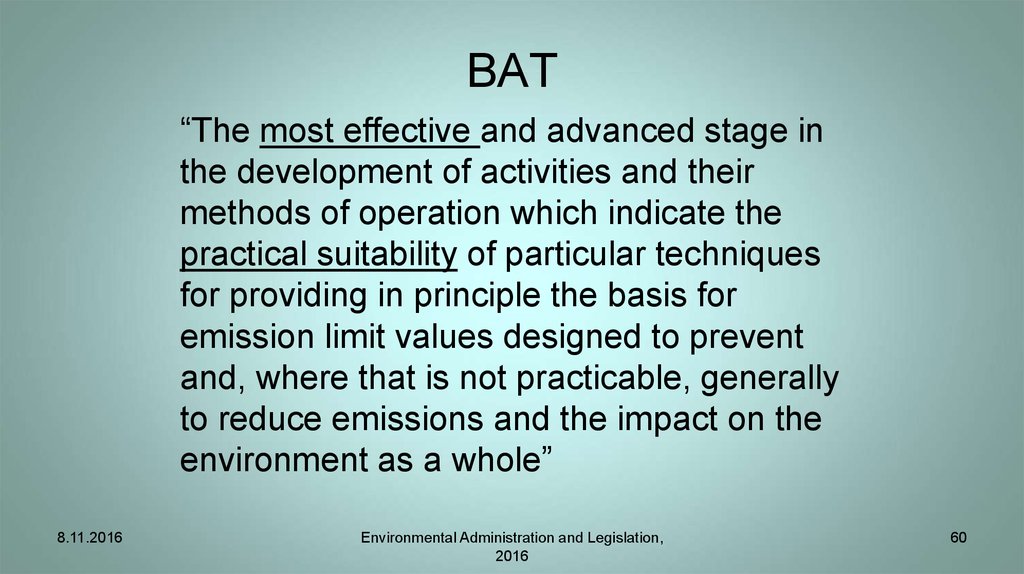







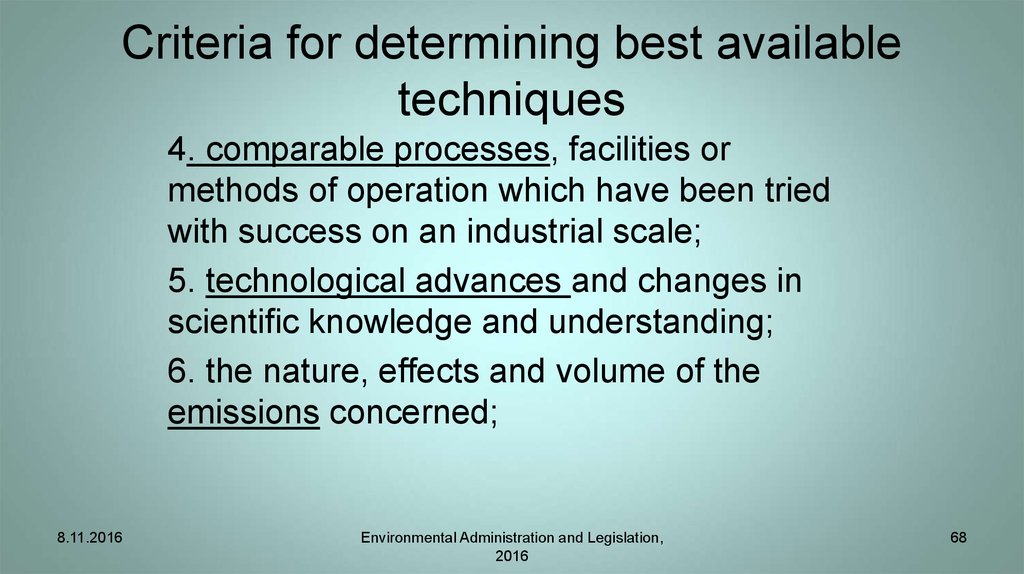







 ecology
ecology








